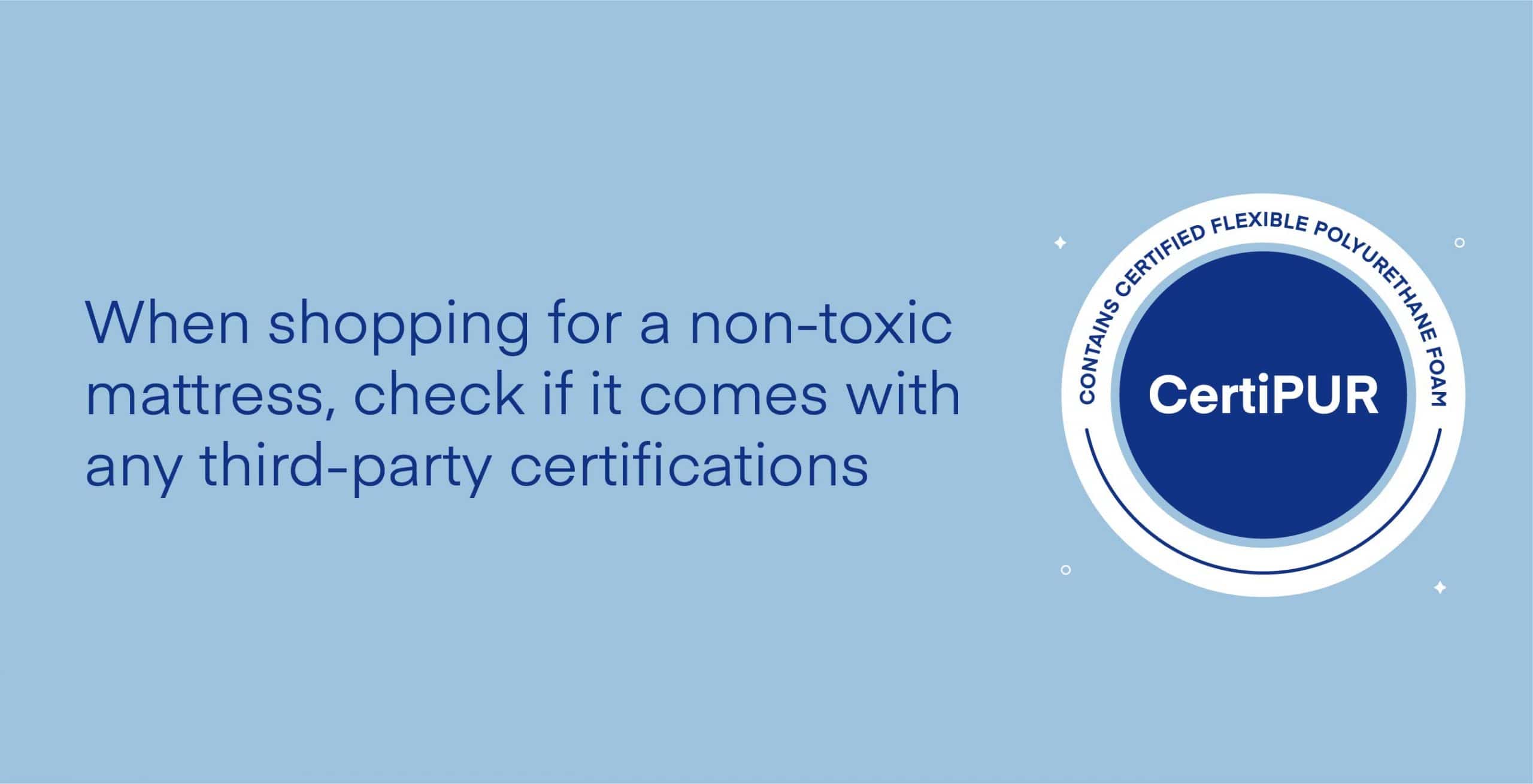To limit their exposure to chemicals, many consumers are switching to non-toxic versions of everyday household items. Everything from cleaning supplies to cosmetics can be replaced with more natural alternatives. The more we know about the formulation of each product we bring into our homes, the more conscious we are of its potential effects on our health.
Since we spend a large majority of our time sleeping, our bed should be the first thing we consider when trying to limit our exposure chemicals. In the past, mattress manufacturers have been notorious for using toxic flame retardants in their products. But, with the demand for cleaner products, several brands are now offering non-toxic models.
If you are shopping for a safer mattress, the process may seem overwhelming. With so many materials and certifications available, it can be difficult to find the best mattress. Our comprehensive non-toxic mattress guide will help you through the selection process. Read on to discover how you can bring home a safer, healthier mattress.
What is a Non-Toxic Mattress?
Non-toxic mattresses are constructed without the use of chemicals that pose a risk to human health. But, non-toxic beds can be described in several ways. Some are advertised as “green” or “organic,” while others are labeled as “eco-friendly.” Many brands may even claim their product fits all three of these distinctions. But, what do each of these terms mean? To help you choose a bed that is truly non-toxic, we break down each of these claims.
- Non-Toxic/Chemical Free: Some brands produce mattresses without the use of toxic chemicals that can be harmful to our health. When shopping, be sure you understand why the bed is considered non-toxic. The company may use natural ingredients in the construction of their foam, or they may rely on organic materials. It is important to determine how the bed has earned this claim.
- Eco-Friendly: Eco-friendly mattresses are made with manufacturing methods and materials that create less pollution and waste. In most cases, eco-conscious practices result in a bed that is also non-toxic and safer for us to sleep on.
- Organic: An organic mattress is made of organic materials, such as cotton, wool, or latex. But, in most cases, mattresses are not 100 percent organic. The cover may be the only organic component, while the rest of the bed is not. When shopping, verify which layers are certified organic and which are not. It is also important to note that foams such as memory foam and poly-foam cannot be organic. These foams are manufactured, not grown, or harvested. They can be produced without the use of toxic chemicals, but they cannot be considered “organic.”
- Green: A brand claiming to produce a “green mattress” could suggest several different things. They may use organic materials, or they may rely on eco-friendly construction methods. If you see this claim, it is essential that you understand how the brand creates a mattress that is “greener” and, therefore, safer for you and the planet.
The Benefits of a Chemical Free Mattress
Making the switch to a chemical-free mattress comes with several benefits. In general, we spend about a third of our lives in bed, so we need to rest on materials that will not harm us from long-term exposure.
- Health benefits: Conventional mattresses rely on fire retardants, adhesives, and dyes that pose serious health risks. Non-toxic, organic, or eco-friendly mattress options are less likely to contain any of these harmful chemicals.
- Reduce allergies: If you suffer from allergies, a chemical-free mattress may alleviate your symptoms. Beds produced with safer ingredients are often hypoallergenic. Plus, they have minimal VOC (Volatile Organic Compounds) emissions that often irritate the lungs.
- More breathable: Mattresses made with non-toxic materials have more breathability. More natural materials such as plant-based foam and latex foam, wick heat and moisture away from the body so you can sleep cool and comfortable.
- Environmental impact: Non-toxic mattress brands often have an environmentally friendly approach to manufacturing. These brands produce less pollution and use sustainable harvesting practices.
- Longer lifespan: A safer, healthier mattress will have a longer lifespan than a conventional one. Chemical laden products tend to break down quickly. The more natural components the bed has, the longer it will last. A high-quality plant-based memory foam mattress will last between 8 and 10 years. Natural latex foam can last around 12 years. On average, conventional beds tend only to last around 6 years.
Best Non-Toxic Mattress Materials
To help you identify which beds are safer for you and your family, we outline the best non-toxic mattress materials.
Plant-Based Memory Foam
The best memory foam mattresses offer superior contouring and pressure relief that is difficult to find with any other type of bed. But, traditional memory foam is made with petroleum chemicals that can be harmful to sleep on. However, plant-based memory foam is partially made with plant-based oils that are non-toxic and safer for both you and the environment.
Plant-based foams help create a sleep environment that is more breathable than traditional memory foam. Plus, this material is low in VOC emissions, so you can rest assured that it is safe to bring into your home. Plant-based memory foam is also more durable than standard foams and less expensive than latex foam.
While you won’t come across plant-based memory foam that is certified organic, these beds are tested to ensure they pose no risk to human health. Further down in this article, we cover the certifications to look for when shopping for a non-toxic memory foam bed.
Natural Latex Foam
Latex is harvested from the sap of the rubber tree, which is a highly sustainable and durable crop. These trees do not require the use of pesticides and can be tapped many times before being cut down. This process makes latex a more eco-friendly option.
Latex foam can be either synthetic and natural. Synthetic latex is often made with toxic chemicals that are not safe for human contact. Natural latex foams, such as Dunlop or Talalay latex, are safer alternatives. Plus, natural latex is antimicrobial, biodegradable, resistant to mold growth, and highly durable.
Dunlop latex is not treated with any chemicals or fillers after harvesting and often has a firm feel. Natural Talalay latex is treated with non-toxic fillers to give it more bounce. Talalay foam often has a medium to medium-firm feel.
Latex mattresses made with either of these foams are non-toxic and safer for you. To ensure that latex foam in your bed is pesticide-free, look for latex with organic certifications from GOLS.
Organic Cotton
Cotton is a fast-growing and hardy crop that is used in everything from bedding to clothing. It is naturally hypoallergenic, breathable, soft, and makes an ideal mattress material. However, due to the popularity of cotton, these crops are heavily saturated with pesticides. When shopping for a non-toxic mattress, be sure to look for one that uses certified organic cotton.
Organic Wool
Wool is frequently used in chemical-free mattresses since it is a natural flame retardant. This material also helps to regulate body heat and moisture. Although wool is a natural material, it is often treated with chemicals. However, certified organic wool does not have any chemical additives or preservatives. Plus, the sheep must not be given synthetic hormones or be left to graze on land that has been sprayed with pesticides. These practices ensure a non-toxic and chemical-free material.
Coils
Both innerspring and hybrid mattresses have a spring coil support base. In a hybrid, these coils are pocketed to create independent movement and adequate contouring. Since these coils are wrapped in fabric, it is difficult for dust mites and dirt to build-up inside the bed. However, with traditional spring coils, there is more open space for harmful contaminants to accumulate.
In general, metal coils pose no health risk and are safe for human contact. For a cleaner mattress that will be less likely to collect dust, opt for a hybrid bed with pocketed spring coils.
Flammability Standards
Before 2007, there were no safety regulations regarding mattress flammability. As a result, a high number of deaths occurred each year due to bed fires. Therefore, the Consumer Product Safety Commission (CPSC) created new flammability standards. These new regulations would ensure that each mattress sold in the US was resistant to fire.
The push for fire-resistant materials caused many brands to turn to toxic chemicals to pass strict flammability tests. These chemicals put consumers in even greater danger because many of them are harmful and lead to serious health conditions. Chemicals such as PBDEs (polybrominated diphenyl ethers) became a popular flame retardant. However, this chemical is now linked to thyroid, liver, and neurological disorders. PBDEs are now banned in many states and monitored by the Environmental Protection Agency (EPA).
Mattress companies can no longer use PBDEs to meet fire safety standards. But, other dangerous chemicals are not banned and can pose health risks. Below, we outline the fire-resistant chemicals that are harmful and those that are safe.
Harmful Flame Retardants
The following chemical flame retardants have been linked to severe health conditions by the National Institute of Health, Verified Source National Library of Medicine (NIH) World’s largest medical library, making biomedical data and information more accessible. View source including cancer, fertility issues, genetic defects, hormonal imbalance, and reduced thyroid and liver function.
- PBDEs: As mentioned above, PBDEs were banned in 2007. This flame-resistant chemical has been shown to cause learning disabilities and hyperactivity. Plus, hormone function and liver function decrease with long-term exposure.
- TCEP: Under California Proposition 65, TCEP is listed as a known carcinogen due to its link to impaired fertility. This chemical is also shown to cause a hormonal imbalance and neurotoxicity.
- TDCPP (Chlorinated Tris): Chlorinated tris is linked to altered hormone levels, certain types of cancers, and reproductive issues. It is also listed as a known carcinogenic under California Proposition 65.
- Brominated flame retardants: Some fire retardants contain brominated chemicals such as bromine. These chemicals are known to cause disruptions to the endocrine and reproductive systems.
- Antimony: Air contaminated with antimony has been shown to irritate the eyes, heart, and lungs. It may also cause stomach pains, diarrhea, vomiting. With long term exposure, severe heart and lung issues can occur.
- V6: Like TCEP, V6 contains an impurity that makes it toxic to humans. V6 has been linked to reproductive issues and poor liver and thyroid function.
- Boric Acid: Boric acid is often sprayed on the cover of the mattress or within the layers. This chemical fire retardant can also be used in other household items such as cleaners and cosmetics. Symptoms of boric acid exposure can range from mild to severe and often include skin, eye, and respiratory tract irritation.
It is best to avoid products that use any of these toxic fire retardants. Not only are they unsafe for human contact, but they will also leave behind a strong chemical odor in your home. This odor can lead to eye and skin irritation and trouble breathing. In more severe cases, it can cause headaches and nausea.
Safe Flame Retardants
To avoid using these chemicals, many brands use natural flame retardants or fire barriers. As you shop, look for a mattress that uses one of these non-toxic materials.
- Pure Wool: Wool is naturally fire-resistant and does not need to be treated with any chemicals. Many brands include a wool fire barrier just under the mattress’s surface. This layer protects sleepers from a fire without any dangerous additives.
- Silica: Silica is a naturally occurring and abundant mineral found in water, soil, and plants. When dehydrated and reduced to a particle, it acts as a natural flame retardant. Today, silica is one of the most popular non-toxic fire-resistant materials and can be found in a variety of products.
- Kevlar: Kevlar is a synthetic material made of durable plastic fibers that are fire-resistant. In a mattress, a layer of kevlar is placed just below the surface of the bed. This material is not treated with any harmful chemicals, is non-toxic, and safe for human contact.
Other Potentially Dangerous Mattress Additives
In addition to flame retardants, mattresses may have other harmful materials. When shopping for a healthier mattress, avoid those with the following additive.
- Ozone depleters: Gaseous compounds such as chlorofluorocarbon Verified Source National Library of Medicine (NIH) World’s largest medical library, making biomedical data and information more accessible. View source (CFC) are harmful to the planet and human health. Although many ozone depleters are banned in the US, they may still be used in products manufactured outside the country. With long term exposure, inhaling CFC can lead to serious respiratory diseases.
- Mercury, lead, or heavy metals: Mercury, lead, and other heavy metals Verified Source National Library of Medicine (NIH) World’s largest medical library, making biomedical data and information more accessible. View source are often added to foam during manufacturing. These additives are linked to kidney and brain damage, as well as digestive problems.
- Phthalates: Phthalates are industrial chemicals used to soften polyvinyl (PVC). They have been shown to cause reproductive complications, kidney, and liver dysfunction.
- Formaldehyde: Formaldehyde is present in several household items, including furniture, glues, and cleaners. However, according to the EPA, Verified Source Environmental Protection Agency (EPA) Works to control/prevent natural and manmade disasters. View source it is dangerous for human contact and is linked to nasal and throat irritation. Long term exposure can lead to asthma and allergies.
- Pesticides: Fabrics that are sprayed with harmful pesticides pose a serious health risk. Many of the pesticides Verified Source National Library of Medicine (NIH) World’s largest medical library, making biomedical data and information more accessible. View source used on cotton, which is a common mattress material, have been linked to cancer and organ failure with long term exposure.
- Benzene: Benzene is often used in plastics, dyes, detergents, glues, and pesticides. However, it is a dangerous chemical Verified Source World Health Organization (WHO) United Nations agency whose stated goal is to improve the health of all. View source that has been shown to reduce bone marrow function and red blood cell counts. Both of these side effects can decrease our immune function and make it difficult to fight infection.
- Toluene: Toluene is often present in industrial adhesives. According to the NIH, Verified Source National Library of Medicine (NIH) World’s largest medical library, making biomedical data and information more accessible. View source it causes nausea, headaches, and dizziness if inhaled.
Non-Toxic Mattress Certifications
Many third-party organizations test mattresses for harmful chemicals before they can be sold to the public. Certification processes ensure manufacturers are honest with their consumers and are keeping them safe from potential health risks.

The following third-party certifications will help you identify a bed that is non-toxic.
- CertiPUR-US®: CertiPUR-US® tests polyurethane mattress foams, including memory foam and poly-foam. This testing process ensures the foam used in the bed is free of ozone-depleting substances, PBDEs, TDCPP, and TCEP (Tris) flame retardants, mercury, lead, and other heavy metals, phthalates, and formaldehyde. They also guarantee the foam has minimal VOC emissions. If you are considering a mattress made with foam, a CertiPUR-US® certification will help you find one that is safe for you and your family.
- GreenGuard: A GreenGuard certification can apply to several household items, including mattresses. GreenGuard tests that the product has little to no VOC emissions and is safe to bring inside the home. A GreenGuard Gold certification may apply to products used in healthcare facilities, for children, or the elderly.
- Global Organic Textile Standard (GOTS): A GOTS certification guarantees the fabrics in the mattress are at least 70 percent organic. This testing also ensures the company is using sustainable manufacturing practices.
- Global Organic Latex Standard (GOLS): A GOLS certification guarantees the latex foam in the mattress is at least 95 percent organic. GOLS verifies the latex was grown and harvested with sustainable methods and is free of harmful additives.
- OEKO-TEX Standard 100: A OEKO-TEX 100 certification tests every material used in the mattress, including fabric, foam, thread, and buttons. This testing ensures that it is free of chemicals and additives that could pose a risk to human health.
- Eco-Institut: The Eco-Institut tests household furniture, mattresses, bedding, and flooring. They ensure no harmful substances such as formaldehyde, VOCs, and acetaldehyde are present in the product.
- Made Safe: Made Safe verifies all materials in the mattress have no suspected environmental or health risks.
Amerisleep Commitment to Your Health and the Health of the Planet
At Amerisleep, we are committed to providing our customers with non-toxic and eco-friendly mattresses. To construct our plant-based memory foam, Bio-Pur®, we replace a portion of the petroleum-based oils with castor oil. This process creates a foam that is cleaner and safer for our customers. Plus, Bio-Pur® has minimal VOC off-gassing and is eco-friendly—making it one of the healthiest memory foam mattresses on the market today.
Each of our memory foam mattresses and hybrid models has a Bio-Pur® top layer. No matter which of our mattresses you choose, you will reap the benefits of sleeping on a non-toxic, yet comfortable bed.
The base of our hybrid mattresses is made of steel spring coils that have been wrapped individually. Pocketed spring coils create a cleaner sleep surface because contaminants are less likely to build up in the bed—making these beds more suitable for those with allergies and asthma.
Certifications
A CertiPUR-US® certification backs each component of our mattresses. This testing guarantees it is free of harmful substances such as formaldehyde and toxic flame retardants. CertiPUR-US® also recognizes that our manufacturing methods are safe and produce fewer VOC emissions.
Natural Flame Retardants
Instead of relying on harmful fire retardant chemicals, we use natural silica. Silica is both safe for the planet and human contact. By using silica, we can construct a mattress that is healthier for you and your family.
Eco-Friendly Innovative
Since 2010, we have constructed our advanced memory foam mattresses using eco-friendly materials and manufacturing processes. The use of plant-based oils in our Bio-Pur® foam results in less pollution and waste. We work hard to reduce our carbon footprint by making our products here in the United States, and by using eco-conscious shipping and storage methods. We also help customers donate unwanted mattresses.
Non-Toxic Mattress Shopping Checklist
To make the shopping process easy, we have included a checklist of important mattress safety tips.
- If the mattress features memory foam, be sure these layers are partially made with plant-based oils. Fewer petroleum-based oils result in a clean, non-toxic sleep surface. A CertiPUR-US® or GreenGuard certification will also ensure it is free of harmful chemicals.
- If the bed features latex, all foam layers should be organic and backed by a GOLS certification. Avoid any latex foam that is synthetic or made with toxic chemicals.
- If you are looking for a mattress with organic materials, select one with a GOTS certification. This certification ensures the textiles in the bed are free of harmful pesticides. Also, it is essential to understand what layers the certification applies to. It may only apply to some fabrics, but not all.
- Does the company claim their mattresses are “green” and “non-toxic”? If so, be sure you understand the facts behind these claims and what certifications are in place to support them.
- If the mattress is a hybrid model, verify that all foam layers are non-toxic and supported by a CertiPUR-US® or GreenGuard certification. It is also helpful to purchase one with pocketed spring coils since they tend to remain cleaner.
- What type of flame retardants does the mattress contain? A non-toxic mattress will use either a wool or kevlar fire barrier or natural silica particles.
- If the company does not list any flame retardants, determine how the product meets flammability standards. You don’t want to bring any harmful chemicals into your home, but you also don’t want a highly flammable mattress either.
Frequently Asked Questions
Are foam mattresses safe for babies?
Foam mattresses guaranteed non-toxic by CertiPUR-US® or GreenGuard Gold are safe for babies and toddlers. However, babies must not sleep on a soft foam mattress that could cause them to suffocate or overheat. Crib mattresses should be firm and should not contour to your baby’s body or trap heat.
How much does a non-toxic mattress cost?
Customers can expect to pay between $1,000 and $2,000 for a non-toxic, eco-friendly bed. If the mattress is certified organic through GOLS or GOTS, it may cost between $2,000 and $2,500. While this may be more expensive than an innerspring model, chemical-free beds are more durable and will support you for many years. A cheaper bed made with harmful additives will deteriorate and break down quickly, leaving you to sleep on a lumpy, uncomfortable mattress.
What mattresses last the longest?
Memory foam and latex foam mattresses have the longest lifespan. A high-quality memory foam bed will last between 8 to 10 years, while a latex foam mattress will last around 12 to 15 years.
Innerspring mattresses and those with adjustable layers of air have the shortest life span. Spring coils tend to break and bend quickly, causing them to stick up into sleepers and create painful pressure points.
Beds with adjustable layers of air also frequently break. Air pumps and hoses can become blocked and develop leaks. These repairs can become costly if they are not covered by a warranty.
Can I be allergic to my mattress?
Mattresses can cause allergic reactions. If the bed is made with harmful chemicals, the off-gassing could make allergy symptoms worse. Innerspring beds have open spaces between the coil springs. In some cases, dust, dirt, and other pollutants can build-up in the bed, causing an allergic reaction.
If you suffer from allergies, a mattress made with hypoallergenic latex or plant-based memory foam may be a good choice for you. Since these foams are so dense, they are less likely to collect harmful allergens.
Pesticides can also trigger allergic reactions, so that you may sleep more comfortably on a mattress made with organic materials.
How dangerous is mattress off-gassing?
If the mattress contains toxic chemicals and flame retardants, off-gassing can be harmful. In some cases, off-gassing results in trouble breathing, headaches, and skin irritation. But, if the mattress does not contain harmful chemicals, the off-gassing will be minimal and less irritating.
Conclusion
Before you buy a new mattress, it is essential to verify each claim related to the bed’s safety and toxicity. Statements that are not backed by certifications may be an attempt to make their products look safer than they are. This is called “greenwashing”—a marketing tactic that falsely claims to be “green” to appeal to more customers. Verifying certifications, flame retardants, and eco-friendly claims will ensure the bed you purchase is truly non-toxic.
Deciding to buy a healthier mattress for yourself and the planet will have several benefits. You will be exposed to fewer toxins and sleep soundly knowing that no harmful additives are lurking in your bed. Plus, it can feel good to support a mattress company that is protecting the environment and the health of its customers.
About the author
Stacy Liman is a journalism graduate student and a freelance writer with a focus on mindfulness and content marketing. Stacy enjoys discovering new mattresses and connecting people with their perfect bed, but she more so enjoys understanding and writing about the science of sleep to help people get deeper, healthier rest.
View all posts





